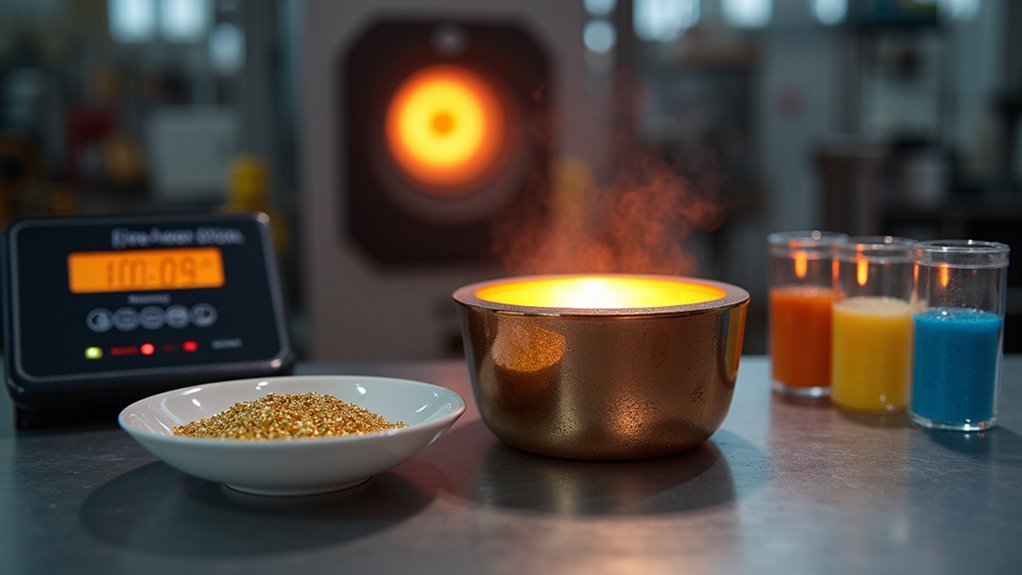You can evaluate metal quality using three primary methods: acid testing, XRF technology, and fire assay. Acid testing offers a quick, affordable approach by scratching metal on a touchstone and applying specific acids, though it’s subjective and involves hazardous chemicals. XRF technology provides precise, non-destructive electronic measurement using X-ray fluorescence, analyzing up to 22 elements simultaneously in seconds. Fire assay represents the gold standard for precious metals, achieving accuracy within parts per thousand through high-temperature melting. Each method below offers unique advantages for your specific evaluation needs.
Acid Testing for Metal Purity Assessment

When you’re looking to assess metal purity quickly and affordably, acid testing offers a traditional approach that’s been used for generations. You’ll scratch your metal sample on a touchstone, then apply specific acids that react differently based on karat content and purity levels.
However, acid testing produces subjective results since visual interpretation varies between users, affecting metal quality assessments. You’re also handling hazardous chemicals that can cause burns without proper precautions.
Acid testing relies on visual interpretation that varies between users and requires handling dangerous chemicals that can cause severe burns.
While this method remains popular, it’s less accurate than advanced methods like fire assay or thorough lab analysis.
That’s why many professionals now favor non-destructive methods such as portable XRF analysis, which deliver precise results without safety risks or potential damage to your valuable metals.
Electronic Metal Analysis With XRF Technology
While acid testing relies on chemical reactions and visual interpretation, XRF (X-ray fluorescence) technology transforms metal analysis through precise electronic measurement. This non-destructive testing method delivers rapid results in seconds, providing thorough elemental analysis without damaging your samples.
You’ll appreciate XRF’s efficiency as it measures up to 22 elements simultaneously, identifying complex alloy compositions with exceptional accuracy. Unlike traditional testing methods, you won’t need extensive sample preparation, reducing both time and costs considerably.
XRF technology excels at distinguishing closely related alloy grades, enhancing your metal quality evaluations.
Whether you’re analyzing ferrous and non-ferrous metals in aerospace, automotive, or recycling applications, this versatile tool provides the precise data you need for confident decision-making across diverse industrial sectors.
Fire Assay for Precise Metal Content Determination

Although modern electronic methods like XRF provide rapid analysis, fire assay remains the gold standard for determining precious metal content with unmatched precision.
Fire assay delivers unmatched precision for precious metal analysis, making it the industry gold standard despite newer electronic alternatives.
This industry standard method achieves accuracy within parts per thousand by melting your samples at high temperatures between 1,100-1,200 degrees Celsius. You’ll need fluxes like lead oxide and borax to facilitate separation of precious metals from base materials during the smelting process.
While fire assay delivers unparalleled accuracy for gold and silver analysis, you should consider that it’s a destructive testing method. Your sample gets consumed during the process, making it unsuitable when preservation’s required.
Despite this limitation, mining and metallurgy professionals rely on fire assay for critical metal content analysis where precision matters most.
Frequently Asked Questions
What Are the Methods of Metal Analysis?
You can analyze metals through visual inspection, spark testing, non-destructive methods like ultrasonic testing, chemical analysis for composition, and metallography to examine microstructure. Each technique reveals different aspects of metal quality and properties.
What Are the Methods of Metal Testing?
You’ll use visual inspection for surface defects, spark testing for steel classification, tensile testing for strength properties, hardness testing for deformation resistance, and non-destructive methods like ultrasonic testing for internal evaluation.
What Is the Best Method to Test for Metals?
You’ll get the best results by combining multiple techniques like visual inspection, spark tests, and XRF analyzers. This all-encompassing approach guarantees you’re accurately identifying metal composition and detecting any internal defects.
What Tests Are Commonly Used to Identify Metals?
You’ll commonly use spark tests to identify carbon content, visual inspections for surface characteristics, chip tests for hardness assessment, magnetic testing for ferrous classification, and non-destructive methods like ultrasonic testing.
In Summary
You’ve now learned three reliable methods to evaluate metal quality. Acid testing gives you quick purity results, XRF technology offers non-destructive electronic analysis, and fire assay delivers the most precise content determination. Each method serves different needs depending on your accuracy requirements and budget. Choose acid testing for basic assessment, XRF for convenience, or fire assay when you need laboratory-grade precision for valuable metals.





Leave a Reply